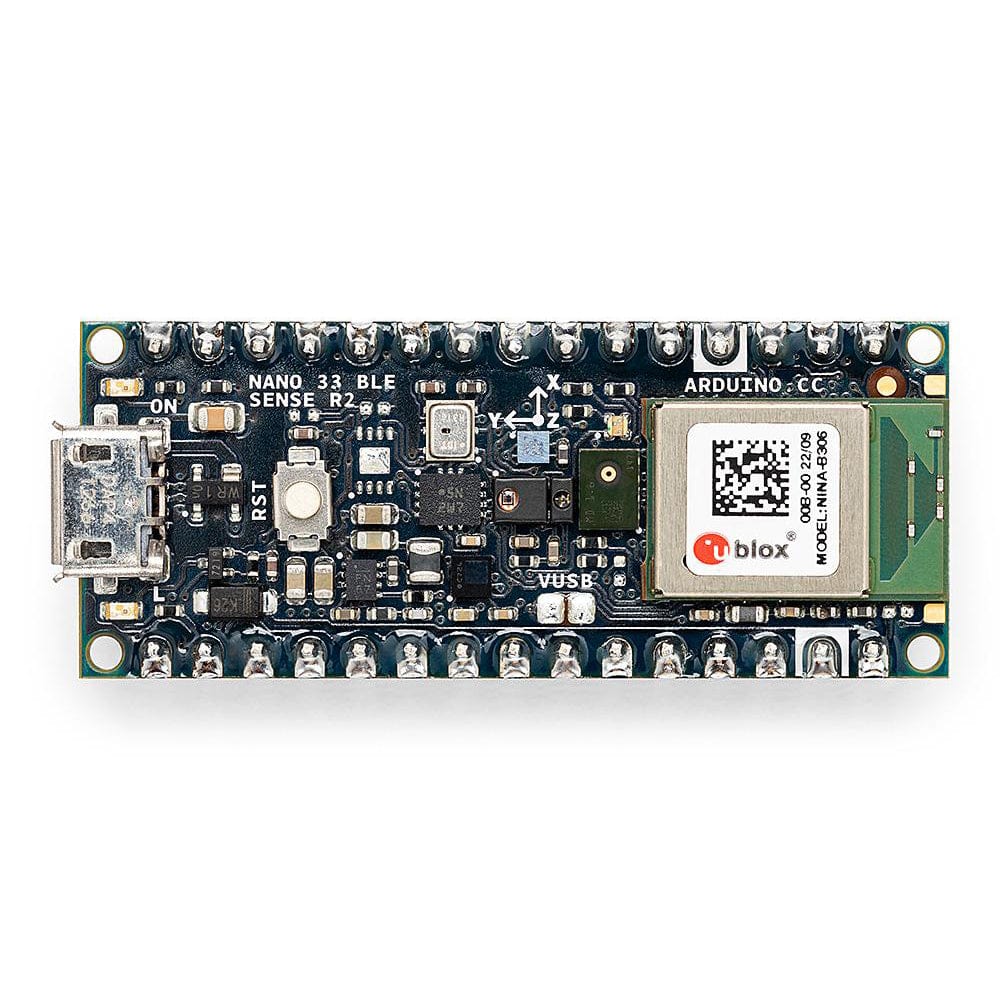




Login / Signup
Cart
Your cart is empty





The Nano 33 BLE Sense REV2 (with headers) is Arduino’s 3.3V AI-enabled board in the smallest available form factor: 45x18mm!
The Arduino Nano 33 BLE Sense is a completely new board with a well-known form factor. It comes with a series of embedded sensors:
The Arduino Nano 33 BLE Sense is an evolution of the traditional Arduino Nano, but features a lot more powerful processor, the nRF52840 from Nordic Semiconductors, a 32-bit ARM® Cortex™-M4 CPU running at 64 MHz. This will allow you to make larger programs than with the Arduino Uno (it has 1MB of program memory, 32 times bigger), and with a lot more variables (the RAM is 128 times bigger).
The main processor includes other amazing features like Bluetooth® pairing via NFC and ultra-low power consumption modes.
Silicone sleeve is now available!
Some sensors have changed due to parts supply:
Additionally, some components have been changed in order to improve the experience of the users:
For sketches using the libraries like LSM9DS1 for the IMU or HTS221 for the temperature and humidity sensor, for the new revision, these libraries must be changed to Arduino_BMI270_BMM150 for the new combined IMU and Arduino_HS300x for the new temperature and humidity sensor.
The Getting Started section contains all the information you need to configure your board, use the Arduino Software (IDE), and start tinkering with coding and electronics.
The main feature of this board, besides the impressive selection of sensors, is the possibility of running Edge Computing applications (AI) on it using TinyML. You can create your machine learning models using TensorFlow™ Lite and upload them to your board using the Arduino IDE.
Arduino’s developer Sandeep Mistry and Arduino’s advisor Dominic Pajak have prepared an introductory tutorial to AI on the Nano 33 BLE Sense, but also a more advanced guide on colour detection.
If you used Arduino Nano in your projects in the past, the Nano 33 BLE Sense is a pin-equivalent substitute. Your code will still work, but remember, it operates at 3.3V. This means that you need to revise your original design in case it is not 3.3V compatible. Besides that, the main differences to the classic Nano are:
The communications chipset on the Nano 33 BLE Sense can be both a BLE and Bluetooth® client and host device. Something pretty unique in the world of microcontroller platforms. If you want to see how easy it is to create a Bluetooth® central or a peripheral device, explore the examples in our ArduinoBLE library.
| Microcontroller | nRF52840 (datasheet) |
| Operating Voltage | 3.3V |
| Input Voltage (limit) | 21V |
| DC Current per I/O Pin | 15 mA |
| Clock Speed | 64MHz |
| CPU Flash Memory | 1MB (nRF52840) |
| SRAM | 256KB (nRF52840) |
| EEPROM | None |
| Digital Input / Output Pins | 14 |
| PWM Pins | All digital pins |
| UART | 1 |
| SPI | 1 |
| I2C | 1 |
| Analog Input Pins | 8 (ADC 12 bit 200 k samples) |
| Analog Output Pins | Only through PWM (no DAC) |
| External Interrupts | all digital pins |
| LED_BUILTIN | 13 |
| USB | Native in the nRF52840 Processor |
| IMU | BMI270 (datasheet) and BMM150 (datasheet) |
| Microphone | MP34DT06JTR (datasheet) |
| Gesture, light, proximity, colour | APDS9960 (datasheet) |
| Barometric pressure | LPS22HB (datasheet) |
| Temperature, humidity | HS3003 (datasheet) |














